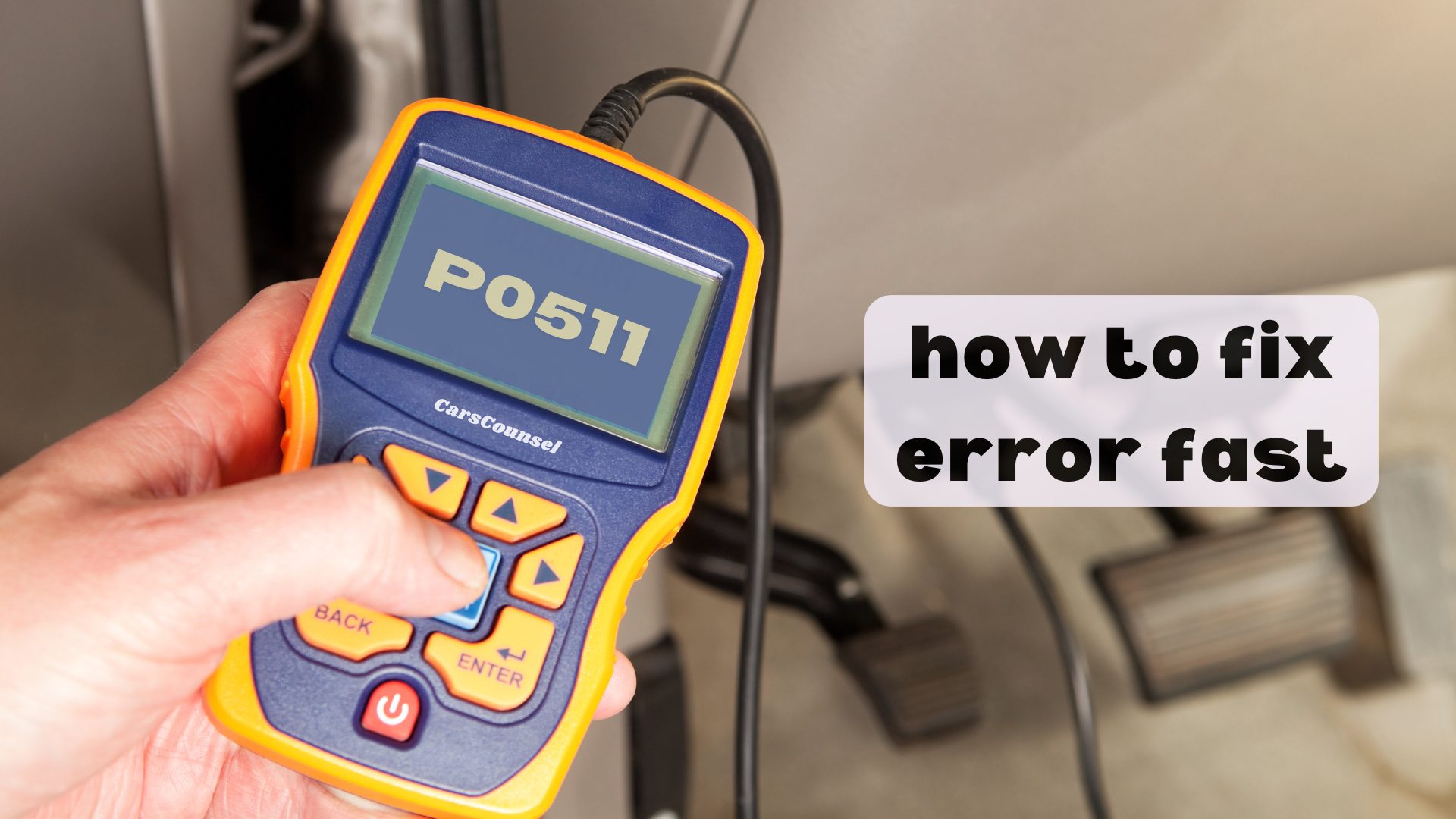When you see a P0511 code, it’s important to fix it right away to avoid more engine problems. This code usually means there’s an issue with the Idle Air Control (IAC) valve, which helps control the engine’s idle speed.
To fix it quickly, start by using an OBD2 scanner to confirm the trouble code and look for any other error codes. Once you verify the error, check the IAC valve, its wiring, and look for any vacuum leaks.
So, how do you find out what’s really wrong and fix it fast? Let’s go over the basic steps you need to follow.

Quick Navigation
Key Takeaways
- Take a look at the Idle Air Control (IAC) valve and clean off any carbon buildup or dirt.
- Check for any damaged wires or loose connections in the IAC circuit and fix them.
- Look for vacuum leaks using a smoke machine or pressure gauges and replace any damaged hoses or gaskets.
- Use an OBD2 scanner to find and fix any related trouble codes from the Powertrain Control Module (PCM).
What Is P0511 Code?
The P0511 code means there’s a problem with the Idle Air Control (IAC) circuit, which helps manage your car’s engine idle speed.
The IAC controls the amount of air entering the engine when it’s idling to keep everything running smoothly. If the IAC circuit isn’t working right, it can mess up this balance, causing issues like high or low idle speeds, poor fuel efficiency, and even stalling.
To figure out what’s wrong, you usually need to use an OBD2 scanner to check the IAC system. Fixing the P0511 code quickly is important for keeping your engine running well and avoiding more problems.
Knowing how the IAC works can help you understand why it’s crucial to address this error code.
Importance of Fixing P0511
Fixing the P0511 code quickly is important for keeping your engine running well and avoiding bigger problems. If you ignore this error, your car might idle roughly, use more fuel, or even stall.
Using tools like an OBD2 scanner to find the problem early is key. By regularly checking the IAC valve and making sure all wiring is in good shape, you can stop this issue from happening again.
Keeping your car’s parts in top condition not only boosts performance but also helps your engine last longer. Acting quickly with the right tools and preventive steps will keep your car running smoothly and save you from expensive repairs later.
Common Symptoms
Several signs can point to a P0511 code, such as unpredictable idle speed, engine stalling, and bad fuel efficiency. If your Idle Air Control (IAC) circuit isn’t working right, it messes with how your engine runs.
You might see your car having trouble keeping a steady idle speed or even stalling unexpectedly at stoplights. Bad fuel efficiency can also show that the IAC system isn’t doing its job properly.
Watch out for these specific symptoms:
- Unpredictable Idle Speed: Idle RPMs going up and down.
- Engine Stalling: Engine shuts off when idling.
- Bad Fuel Efficiency: Using more fuel than usual.
- Rough Engine Performance: Feeling vibrations or rough running.
Spotting these signs early can help avoid bigger engine problems.
Causes of P0511
The P0511 code usually shows up when there’s a problem with the Idle Air Control (IAC) valve, which messes with the air going into the engine.
This can happen if the IAC valve is faulty, or if there are wiring problems like damaged wires or loose connections. Sometimes, the Powertrain Control Module (PCM) mightn’t control the idle speed correctly, causing the error code.
Vacuum leaks from broken hoses or gaskets can also mess with the air intake and cause idle issues.
Weather conditions like temperature and humidity can affect the IAC valve too.
Regular check-ups with diagnostic tools and preventive maintenance can help find these problems early.
Fixing these issues quickly is important to keep your engine running smoothly and avoid bigger problems.
Faulty IAC Valve
When your car has a bad Idle Air Control (IAC) valve, it messes up the airflow and makes your idle speeds jumpy.
Here’s how to keep your IAC valve in good shape:
- Check the IAC Valve: Look for any signs of wear or damage regularly.
- Clean the IAC Valve: Get rid of carbon buildup to keep it working well.
- Test Resistance: Use a multimeter to check the valve’s resistance and make sure it matches what the manufacturer says it should be.
- Adjust Idle Speed: If your car allows it, follow the manual to adjust the idle speed.
Wiring Problems
Wiring Problems
Fixing wiring problems means checking the IAC circuit for any damaged wires or loose connections that might mess things up. Make sure the wires are in good shape by looking for signs of wear, rust, or physical damage. It’s important to check if the circuit is continuous; use a multimeter to test the electrical connections throughout the IAC circuit. If you find any damaged wires or loose connections, fix or replace them right away to get the IAC working properly again.
| Symptom | Possible Cause | Solution |
|---|---|---|
| Loose Connection | Vibration or wear | Tighten connections |
| Corroded Wires | Moisture exposure | Clean or replace wires |
| Broken Wiring | Physical damage | Repair or replace wiring |
| Intermittent Issues | Faulty connectors | Replace faulty connectors |
| Loss of Continuity | Wire fracture | Confirm proper wire continuity |
PCM Issues
Once you’ve made sure all the wiring is okay, you should check that the Powertrain Control Module (PCM) is working properly. The PCM is crucial for managing the Idle Air Control (IAC) system. Troubleshooting the PCM is important to rule out any issues that could affect the idle speed.
Here’s how you can do it:
- Check PCM Connections: Make sure all the plugs and connectors are tight and clean.
- Scan for Codes: Use an OBD2 scanner to look for any trouble codes related to the PCM.
- Inspect PCM Outputs: Use a multimeter to check the signals the PCM sends to the IAC valve.
- Consider PCM Replacement: If the PCM isn’t working right, you might need to replace it.
These steps will help you figure out if the PCM is the problem, making sure your IAC system works as it should.
Detecting Vacuum Leaks
How can you effectively detect vacuum leaks to fix the P0511 code? Start by visually checking all hoses and gaskets. For more accurate leak detection, use tools like a smoke machine or a vacuum testing gauge. These tools help you find leaks that you can’t see with just your eyes.
Here’s what you can do:
| Step | Description |
|---|---|
| Visual Inspection | Look at hoses and gaskets for any signs of damage. |
| Smoke Testing | Use smoke to find leaks in the vacuum system. |
| Vacuum Gauge | Check the pressure to find any inconsistencies. |
| Listen for Hissing | Listen for any hissing sounds that might indicate a leak. |
| Replace Components | Fix any parts that are damaged right away. |
Environmental Impact
Environmental factors like temperature and humidity can have a big impact on how well the Idle Air Control (IAC) system works, which can cause the P0511 code to pop up. These conditions affect how smoothly your engine idles and can lead to uneven performance.
Here’s a breakdown of how the environment plays a role:
- Temperature Swings: Extreme heat or cold can change the density of the air, messing with the IAC valve.
- Humidity: High humidity can cause moisture buildup, leading to electrical problems in the IAC circuit.
- Altitude: At higher altitudes, the air is thinner, so the idle needs to be adjusted differently.
- Seasonal Changes: Quick changes in weather can make the idle speed inconsistent.
Knowing how these environmental factors affect your vehicle can help you keep it running smoothly and avoid the P0511 code.
Step-by-Step Fixes
To fix the P0511 code, start by checking the Idle Air Control (IAC) valve with a multimeter to make sure its resistance matches the manufacturer’s specs.
Next, look over the wiring for any damage or loose connections that could mess with the idle speed control. If the wiring looks good, check for vacuum leaks in the air intake system using a smoke machine or pressure gauge. Replace any broken hoses or gaskets you find.
If the IAC valve is bad, replace it, but keep in mind that the cost can vary.
More OBD-II Codes
Frequently Asked Questions
How Can I Tell if My IAC Valve Is Failing?
To tell if your IAC valve is failing, watch for signs like an uneven idle or stalling. You can also test the valve using a multimeter to check the resistance and make sure it’s within the recommended range.
Can Driving With a P0511 Code Damage My Engine?
Yes, driving with a P0511 code can hurt your engine. It messes with how your engine runs and can cause problems when the car is idling. This can lead to bad gas mileage, stalling, and even long-term damage if you don’t fix it soon.
Are There Temporary Fixes for the P0511 Code?
You might think quick fixes won’t help, but things like cleaning the IAC valve, tightening loose connections, or fixing vacuum leaks can help stabilize idle speed for a short time. However, you should find a permanent fix for long-term reliability.
How Often Should I Replace My IAC Valve?
You should change your IAC valve every 50,000 to 70,000 miles, based on your car’s needs. Taking care of your IAC valve regularly can make it last longer and help avoid problems like rough idling and bad gas mileage.
What Tools Do I Need to Diagnose the P0511 Code?
Imagine your car stalling at a red light. To figure out what’s causing the P0511 code, you’ll need a few tools: an OBD2 scanner to read the error codes, a multimeter to check the Idle Air Control (IAC) valve, and a smoke machine to find any vacuum leaks.
Conclusion
Fixing the P0511 code not only gets your engine running better but also makes your drive smoother and more efficient.
By taking care of the faulty Idle Air Control valve, checking for issues with the PCM, and looking for vacuum leaks, you make sure your vehicle runs properly.
Don’t ignore this error—deal with it right away.
With accurate diagnostics and quick repairs, you’ll keep your engine running smoothly and avoid unexpected breakdowns.
It’s all about keeping things in good working order under the hood.

